Broad awareness of the new issues began with National Geographic, Naked Science, "Earth's Invisible Shield."
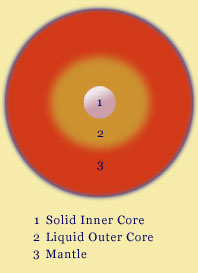 The movement of the largely liquid metal outer
core of Earth around its largely iron solid metal inner core generates
a magnetic field that has been simulated in experiments
with liquid
The movement of the largely liquid metal outer
core of Earth around its largely iron solid metal inner core generates
a magnetic field that has been simulated in experiments
with liquid  sodium. It normally results
in a dipole magnetic field for the planet.
sodium. It normally results
in a dipole magnetic field for the planet.
As the planet cools by convection, the outer core accretes on the inner core, expanding it while thinning the outer core, and reducing the net magnetic field strength. The geomagnetic field strength decrease began about 2000 years ago, but the rate of decrease increased 500 years ago. An analysis of pottery fired over the last 400 years has revealed a geomagnetic field strength decline rate ten times faster than expected. In 1,500 years it is estimated there will be no geomagnetic field.
During the last 20 years, the geomagnetic field has become erratic. Aeronautical maps used to allow aircraft to land using automatic pilot systems have accordingly been revised.
 The Southern Atlantic Anomaly has
forced satellite operators to change the orientation or configuration
of satellites before they pass over the region during a solar flare.
Commercial aircraft must divert or risk a loss of communication. The
anomaly has led many scientists to believe a field reversal is imminent.
The Southern Atlantic Anomaly has
forced satellite operators to change the orientation or configuration
of satellites before they pass over the region during a solar flare.
Commercial aircraft must divert or risk a loss of communication. The
anomaly has led many scientists to believe a field reversal is imminent.
According to ancient lava flows, field reversals occur about every 200,000 years. The last reversal was 780,000 years ago. No mass extinctions have been correlated with magnetic field reversals, but they likely disrupt migratory animals that store electromagnetic field maps for navigation. How long a reversal takes is unknown.
 The geomagnetic field normally
deflects the solar wind around the planet such
that it only interacts with the ionosphere,
where the charged particles (electrons and protons) from the solar wind
are trapped and flow to the poles as evidenced by auroras (auroras
from space).
The geomagnetic field normally
deflects the solar wind around the planet such
that it only interacts with the ionosphere,
where the charged particles (electrons and protons) from the solar wind
are trapped and flow to the poles as evidenced by auroras (auroras
from space).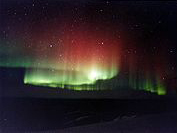
The radiation from coronal mass ejections (CMEs) are often associated with solar flares. CMEs are strong enough to deform the existing geomagnetic field.
NASA's five THEMIS spacecraft have discovered a breach in
Earth's magnetic field ten times larger than anything previously
thought to exist. When this happens, solar wind can flow through the
opening to charge the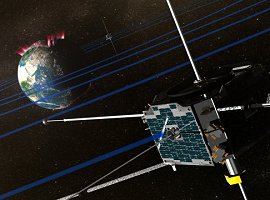 magnetosphere, which can result in communication
and electrical power disruptions like that which disabled the Canadian
grid. Exploring the mystery is a key goal of the THEMIS mission,
launched in February 2007.
magnetosphere, which can result in communication
and electrical power disruptions like that which disabled the Canadian
grid. Exploring the mystery is a key goal of the THEMIS mission,
launched in February 2007.
On June 3, 2007, when the five probes serendipitously flew through the breach just as it was opening. On board sensors recorded a torrent of solar wind particles streaming into the magnetosphere, signaling an event of unexpected size -- 1027 particles per second flowed into the magnetosphere -- an order of magnitude greater than what was thought possible. It's long been believed that holes in Earth's magnetosphere open only in response to solar magnetic fields that point south, and those that point north reinforce the geomagnetic field. This breach opened in response to a solar magnetic field that pointed north.
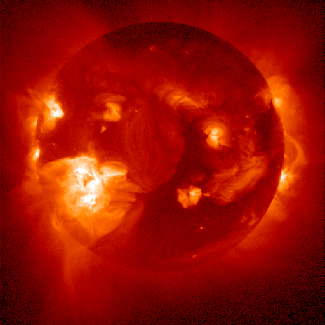
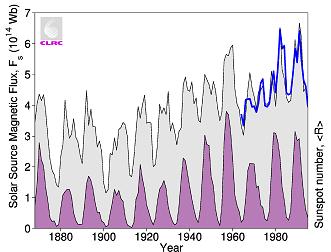 Since 1901 the overall magnetic field of the Sun
has increased by 230 percent. Some of the sunspot activity in
this last cycle was greater than anything ever recorded.
Since 1901 the overall magnetic field of the Sun
has increased by 230 percent. Some of the sunspot activity in
this last cycle was greater than anything ever recorded.
For reasons not fully understood, CMEs in even-numbered solar cycles
tend to hit Earth with a leading edge that is magnetized north. Such
CMEs may now open a breach and load the magnetosphere with plasma just
before the storm gets underway -- a perfect storm.
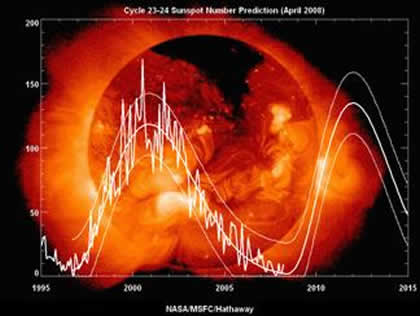 Every 10–11 years, the number
of sunspots increase from 0 (solar cycle 23 in 2008) to over 400. The
solar flares and other
disturbances emanating from the sun during increased sunspot activity
result in an increased solar wind and
harmful radiation (ultraviolet and x-rays).
Every 10–11 years, the number
of sunspots increase from 0 (solar cycle 23 in 2008) to over 400. The
solar flares and other
disturbances emanating from the sun during increased sunspot activity
result in an increased solar wind and
harmful radiation (ultraviolet and x-rays).
Sunspot Cycle 24 will peak around 2012. This sunspot cycle will be 30-50% stronger than the last one and begin as much as a year late, according to a computer model of solar dynamics developed by scientists at the National Center for Atmospheric Research (NCAR). In a series of test runs, the newly developed model simulated the strength of the past eight solar cycles with more than 98% accuracy.
2008 has proven to be an anomoly indicating that solar partical flux does not necessarily correlate with sun spots.
On August 28, 1859, auroras glowed and shimmered all over the American continent as darkness fell. Many people thought their city was aflame. The instruments used to record this magnetic fluctuation exceeded their limit. Hit by a massive voltage surge, telegraph systems malfunctioned. A study by the MetaTech Corporation revealed that an impact similar to that of 1859 would incapacitate the entire electricity grid in North America. Even the relatively weak magnetic storm of 1989, disabled a Canadian hydroelectric power plant that left 6 million people in the U.S. and Canada without electric power for nine hours.
According to the Laboratory for Atmospheric and Space Physics at the University of Colorado in Boulder, related consequences of a major undeflected solar event include potable water distribution affected within several hours; perishable foods and medications lost in 12-24 hours; immediate or eventual loss of heating/air conditioning, sewage disposal, phone service, transportation, fuel resupply and so on. Outages could take months to fix. Banks might close, and trade with other countries might halt. Emergency services would be strained, and command and control might be lost.
The heliosphere is the furthest extent of the solar wind. It extends more than a million miles an hour from the sun. It has shrunk by 20 per cent over the past decade, allowing 20% more high energy electrons to strike Earth. The heliosphere is at its lowest level since the space race began 50 years ago. The IBEX probe is intended to determine why.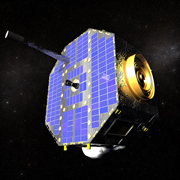
About 90 per cent of the cosmic particles striking the solar system are deflected by the heliosphere. Much of the rest is deflected by the Earth's magnetic field. The Earth's atmosphere absorbs much of the remainder. Cosmic particles have detrimental effects on DNA, increasing the risk of cancer, cataracts, neurological disorders, and non-cancer mortality risks.
If the heliosphere continues to weaken, scientists fear that the amount of cosmic radiation reaching the inner parts of our solar system, including Earth, will increase to disruptive levels. The reversing and declining geomagnetic field compounds the concern.
Though smaller, Mars likely had a magnetic field similar to that of Earth. When it lost its magnetic field, its atmosphere was stripped away by the solar wind, and its oceans evaporated. If further research indicates that Earth will follow Mars into inhospitality, the deadline for mass migrations of life from Earth to another solar system is near the year 3500. That leaves precious little time to master interstellar travel, find suitable planets, and master terraforming.
See also Magnetics Surveying.
On 2010 September 16 a History Channel episode on the magnetosphere entitled "Magnetic Storm" revealed that the power grid is humanity's Achille's Heel, because other infrastructure like water and fuel pumps need electricity to work. It takes six months to build a replacement transformer in a major city. It will take ten years to repair the electrical grid. In that time, one-third to one-half of the population of the developed world will die.